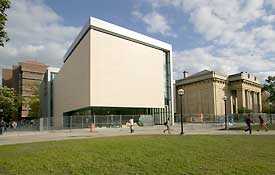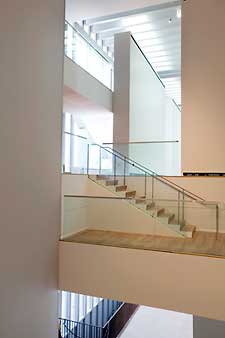March 28 reopening to reveal hip, lively town square for the arts
Museums reborn in the 21st-century travel a long, difficult road from blueprint to grand-opening ribbon-cutting. In these tough economic times, that road for nonprofit cultural institutions is becoming even steeper.

Despite the current financial struggles throughout the museum world and beyond, the March 28 reopening of the expanded U-M Museum of Art offers a much-needed sign of hope, and serves as a testament to the wonders of patronage and rewards of persistence.
“We are committed to giving visitors experiences of the full range of creative expression, and to building connections across cultures and across creative disciplines,” says James Steward, director of UMMA. “With the opening of a new wing and the restoration of our historic building, we now have the space to present our collections and exhibitions, and to partner with arts organizations throughout the university and the Ann Arbor arts community.
“The aim is to create a town square for the arts, and in doing so become one of the most dynamic university museums in the country.”
The $41.9 million expansion and restoration of UMMA reveals a distinctively 21st-century approach to the ongoing transformation of museums as a public trust. The revamped space is symbolically located at the intersection of campus and community. Its collections represent 150 years of art collecting at the University, with an increased range and amount of programming to position the museum as a meeting place for the arts.
The main goal for the new museum, Steward says, is to become a vibrant venue for the 40,000-member student community eager for academic and social opportunities centered on the visual arts.

The emphasis on private financing and offering visitors an affordable experience — there is no admission charge — is one of the many signs that UMMA is at the vanguard of university museums in the country, Steward says.
More than 90 percent of funds for building came from private donations for the expansion and restoration, which began in September 2006. The museum’s capital campaign was part of the Universitywide Michigan Difference campaign, which concluded in December. The museum’s campaign focused on increasing endowment and funding for operations as well as for the costs of construction, and generated more than $60 million in support.
The central administration also has made incremental, discretionary allocations of more than $597,000 in base funds and more than $15.1 million in one-time funds to support initiatives, added staffing, and costs related to the museum project.
The centerpiece of the new museum, which more than doubles its size, is the 53,000-square foot addition named the Maxine and Stuart Frankel and the Frankel Family Wing. The Frankels of Bloomfield Hills contributed $10 million to the project.
The glass-and-limestone Frankel Wing addition features a light-filled expanse of galleries, classrooms, an auditorium, and the wide breadth of windows that frame the museum’s new gallery for cutting-edge contemporary art.
The distinctively open, yet intimate atmosphere is likely to attract students looking for a place to contemplate art, study and hang out.
“UMMA is a wonderful new resource for cross-disciplinary programming,” Maxine Frankel says. “It is a showcase for the depth and breadth of the museum’s collections, and encourages visitors, especially students, on their own exploration.”
Principal architect Brad Cloepfil and his firm, Allied Works Architecture of Portland, Ore., designed UMMA’s expansion and restoration. The project received the prestigious design award from the New York chapter of the American Institute of Architects.
The impact of the new multidisciplinary UMMA means a broader range of arts programming and events.
The museum will reopen with newly installed collections galleries featuring works drawn from its collections and three special exhibitions:
• “Museums in the 21st Century: Concepts, Projects, Buildings,” in which UMMA’s expansion and restoration project figures
• “Expressions of Vienna: Master Drawings” by Klim and Schiele from the Pulgram-McSparran Collection, which highlights a recent gift of artwork by two iconic masters of Austrian Expressionism from two U-M professors
• “UMMA Projects: Walead Beshty,” which inaugurates the museum’s new signature series focusing on global contemporary art
A 24-hour public opening — from 6 p.m. March 28 to 6 p.m. March 29 — caps a celebratory week of special events for the museum’s family of donors, members, volunteers, and for faculty, staff and students.

